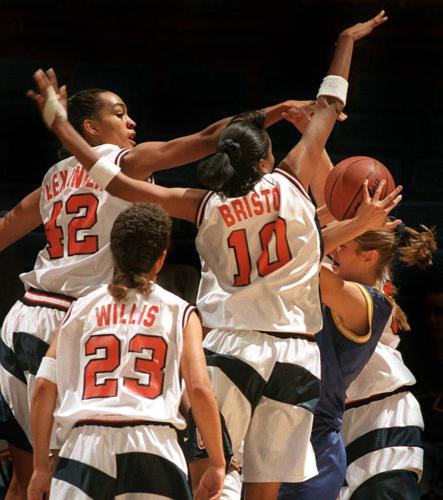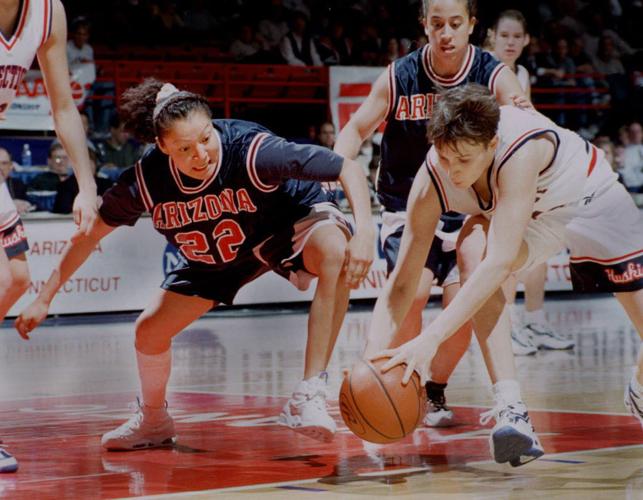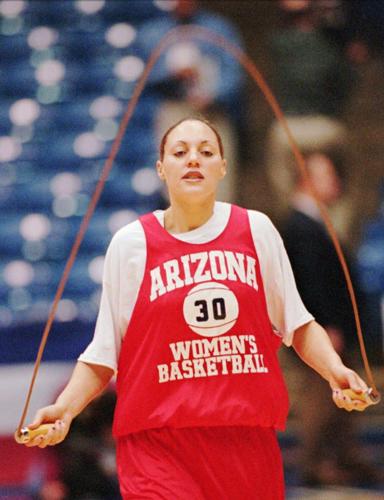The 1997-98 season holds a special place in the hearts of 14 Arizona women’s basketball players and their coach, Joan Bonvicini.
The Wildcats advanced to the Sweet 16 for the first time, where they lost to Connecticut. The UA was ranked as high as No. 7 in the country during its breakthrough season.
The top scorer on that team was the best player in Arizona women’s basketball history, current head coach Adia Barnes. She averaged 21.8 points per game en route to 2,237 career points, the most ever by a Wildcat. Barnes’ performance during her senior season was good enough to earn her Pac-10 Player of the Year honors.
This weekend, a number of Barnes’ teammates traveled to Tucson for a reunion.
On Saturday afternoon, three players — Felecity Willis, Cha-Ron Harris, and Reshea Bristol — joined Bonvicini in reminiscing about that season. The Wildcats will face Washington on Sunday at noon.
What were your first thoughts walking back into McKale Center this weekend and seeing your teammates and coach?
Harris: “It’s always great connecting with everyone. The McKale Center has an electric vibe that is hard to put into words.”
Willis: “Even though I live in Tucson, every time I walk into McKale I get this feeling of joy because it’s a great place to play and it was our second home. Being able to see my teammates is awesome because we had so much fun here and it’s great reminiscing about the good old days.”
Bonvicini: “When I go back, whether it’s to call a game (for Pac-12 Networks), watch a game or practice, it brings back great memories. I loved it at UA; it’s a class university. I worked for and with great people. One of my players from the year after (this run), Angie Lackey, saw me at shoot-around yesterday and remembered me yelling at her.”
Bristol: “I’ve come back a couple of times to campus and the hype all comes back to me. Arizona has a special place in my heart. The family atmosphere in Tucson is like no other place.”
Was that Sweet 16 team the best team you’ve ever played on or coached? What made it so special?
Bonvicini: “I knew we’d be really good. All our players were back. Anytime you are good, talent is important, but even more important is the culture and the work ethic. And this team got along with each other. It was a special team that had something to prove. They were all good kids — but not all highly recruited. But collectively they were really good. They were a blue-collar team that no one wanted to play. We had good depth and were athletic and played with an edge; they never, ever quit.”
Bristol: “Best all-around team I’ve ever played on. All of the closeness just transitioned over onto the court. For instance, knowing where and how each other wanted the ball passed to them was key. And this helped us break individual and team records that year, because we were able to put everyone in the right position to contribute.”
Willis: “Yes, that was the best team I have even been part of, besides making it to the Sweet 16, that was the same year we beat Stanford and that was a huge deal because we had never beaten them before. It was special because we played so well together. Everyone knew their role on the team. We all got along and played for each other.”
Harris: “This team was the best team I’ve played on and we were family. I think the best thing was beating Stanford!”
That shot by Reshea … she hit a buzzer-beater.
Willis: “Haha, you were in my head. Yes, she did. Reshea hit a big shot. She can elaborate on that for you.”
Harris: “She sure did! It was awesome!”
Bristol: “‘The shot’ … It was definitely not drawn up for me. I was a redshirt freshman …(laughs). Of course, the play was drawn up for Adia to score. But when that was defended, the pass was to me just ‘cause I was the closest, I guess. I had Christina Batastini, who had just hit a 3 in my face, guarding me when I received the pass. I glanced over at the scorer’s table and it read like three seconds. I took a dribble to my inside and with a hand in my face I shot the ball and I felt like it was good as soon as it left my hands. Next thing I know I was at the bottom of a dog pile with my arms above my head pressed against the floor.”
Barnes said that game gave you even more confidence for the rest of the season. Do you agree?
Bristol: “I remember us using the ‘David and Goliath’ Bible reference all week. In that game, I was still proving myself, to be a game-changer, to my coaches and teammates. The way we felt before the game started helped our confidence.”
Bonvicini: “It gave us the confidence we needed to get over the top. It’s a really important moment in Arizona women’s basketball history.”
How hard did Adia push you and how was she as a teammate?
Bristol: “Adia was definitely the women’s version of Charles Barkley. I loved being her guard, passing the ball in to see her score at will, completely undersized.”
Willis: “Adia was the consummate leader. She led by example and we were following right behind her. She was a great teammate; worked hard every day. She was an undersized post player and to do the things she did was amazing.”
Harris: “I like everything she said. Adia was a great teammate. She was actually one of my best friends. She was what others called ‘undersized,’ but what she lacked in size she made up for in heart and determination.
“One of the things I appreciated most about being her teammate was not only her physical gift but also her mental (abilities). You never knew what she was feeling. She had the best poker face. I never knew if she was nervous, anxious or upset.”
Willis: “All the time she was going up against post players who were 6-feet-4-inches and taller and bigger. So, for her to do the things she did on the court against really great post players says a lot about how good of a player she was.
“And, like Cha-Ron said, she lacked size but made up for it; she played bigger than she was.”






